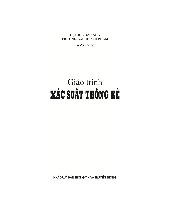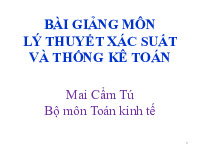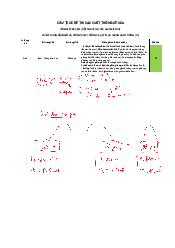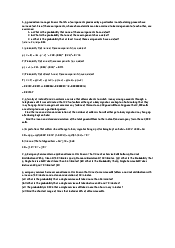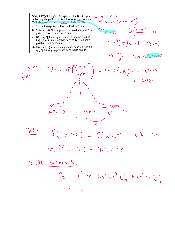



Preview text:
lOMoARcPSD|36340008
1, A produc琀椀on manager knows that 5% of components produced by a par琀椀cular manufacturing process have
some defect. Six of these components, whose characteris琀椀cs can be assumed to be independent of each other, are examined.
1. a. What is the probability that none of these components has a defect?
2. b. What is the probability that one of these components has a defect?
3. c. What is the probability that at least two of these components have a defect?
here n= 6 and p=0.05
1) probability that none of these components has a defect
p ( X = 0) = nCx . px .qn-x = 6C0. (0.05)0 . (0.95)6 = 0.735
2) Probability that one of these components has a defect
p ( x = 1) = 6C1. (0.05)1.(0.95)5 = 0.231
3) Probability that atleast two of these components have a defect
P ( X ≥ 2) = p( X=2) + p( X=3) + p (X=4) + p(X=5) + p(x=6)
= 0.0303+0.00214+0.000084+0.000001778+0.000000015) = 0.03252
2, A family of mutual funds maintains a service that allows clients to switch money among accounts through a
telephone call. It was es琀椀mated that 3.2% of callers either get a busy signal or are kept on hold so long that they
may hang up. Fund management assesses any failure of this sort as a $10 goodwill loss. Suppose that 2,000 calls
are a琀琀empted over a par琀椀cular period.
Find the mean and standard devia琀椀on of the number of callers who will either get a busy signal or may hang up a昀琀er being kept on hold.
Find the mean and standard devia琀椀on of the total goodwill loss to the mutual fund company from these 2,000 calls.
a) Expecta琀椀ons that callers who either got a busy signal or hung up a昀琀er being kept on hold = 0.032* 2000 = 64
SD = npq = sqrt(2000* 0.032*(1-0.032)) = sqrt(61.952) = 7.87
b) Mean of the total good loss = 64*$10 = $640 SD = $10*7.87 = $78.7
3, A Company Services Home Air Condi琀椀oners. It Is Known That Times For Service Calls Follow A Normal
Distribu琀椀on With A Mean Of 60 Minutes And A Standard Devia琀椀on Of 10 Minutes. (A) What Is The Probability That
A Single Service Call Takes More Than 65 Minutes? (B) What Is The Probability That A Single Service Call Takes
Between 50 And 70 Minutes? (C)
A company services home air condi琀椀oners. It is known that 琀椀mes for service calls follow a normal distribu琀椀on with
a mean of 60 minutes and a standard devia琀椀on of 10 minutes.
(a) What is the probability that a single service call takes more than 65 minutes?
(b) What is the probability that a single service call takes between 50 and 70 minutes?
(c) The probability is 0.025 that a single service call takes more than how many minutes?
(d) Find the shortest range of 琀椀mes that includes 50% of all service calls.
Downloaded by Di?u H?ng (nguyendieuhang45@gmail.com) lOMoARcPSD|36340008
(e) A random sample of four service calls is taken.What is the probability that exactly two of them take more than 65 minutes?
Downloaded by Di?u H?ng (nguyendieuhang45@gmail.com) lOMoARcPSD|36340008
1, It has been found that 琀椀mes taken by people to complete a par琀椀cular tax form follow a normal
distribu琀椀on with mean 100 minutes and standard devia琀椀on 30 minutes. A random sample of nine people
who have completed this tax form was taken.
a) What is the probability that the sample mean 琀椀me taken is more than two hours?
b) The probability is 0.20 that the sample mean 琀椀me taken is less than how many minutes?
c) What is the probability that the sample mean 琀椀me taken is less than 70 minutes?
d) What is the probability that a randomly chosen individual takes less than 70 minutes to complete this par琀椀cular tax form?
e. Four people are chosen at random. What is the probability that exactly two of them take longer than an hour to complete this form?
f. For a randomly chosen person, state in which of the following ranges (expressed in minutes) the 琀椀me to complete
the form is most likely to lie. 70-89, 90-109, 100-129, 130- 149 µ = 100 sigma = 30 a)
Downloaded by Di?u H?ng (nguyendieuhang45@gmail.com) lOMoARcPSD|36340008
= P(Z > 2) = 1 - P(Z < 2) = 1 - 0.9772 = 0.0228
or, x = 100 - 0.84 * 20/sqrt(9) or, x = 94.4 c) = P(Z < -3) = 0.0013 d) = P(Z < -1) = 0.1587
Downloaded by Di?u H?ng (nguyendieuhang45@gmail.com)
